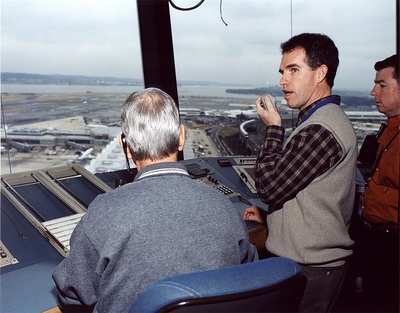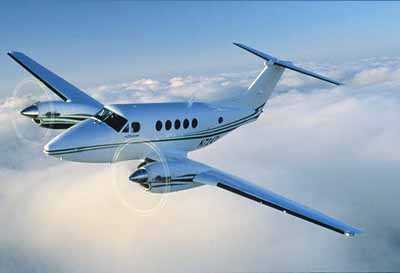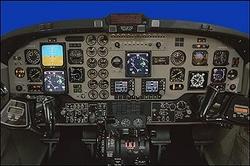TRACON Personnel Guided Doug White To Safe Landing At RSW
 Two air traffic controllers are rapidly earning heaps of praise
for
helping a distressed passenger guide a plane to safety
Sunday after the pilot died in the cockpit.
Two air traffic controllers are rapidly earning heaps of praise
for
helping a distressed passenger guide a plane to safety
Sunday after the pilot died in the cockpit.
Brian Norton and Dan Favio, who both work the TRACON at
Southwest Florida International Airport in Ft. Myers, helped a
passenger sitting in the co-pilot's seat as he guided the
twin-engine plane to safety after the pilot's apparent heart
attack.
"I couldn't be more proud of them," said Steve Bushey, the
tower's manager. "We're happy to have a good story and particularly
because the outcome was positive. You can't beat that."
One of the passengers, Doug White, who previously had only flown
single-engine planes, was forced under the circumstances to fly his
family to the airport after he declared an emergency.
White already had enough on his mind. He was returning to
Louisiana -- with a stop in Mississippi to retrieve his truck --
after attending a funeral for his only brother. His wife and two
teenage daughters were in the back of the plane and now he was
charged with getting them on the ground.
A few minutes into the flight of N559DW, when the King Air 200
was 10,000 feet aloft and climbing, White radioed the Miami Center
that there was an emergency. Controllers at the Ft. Myers airport
were quickly notified, and a radar scope showing only the King Air
was set up in the tower.
Controller Brian Norton was walking down the hallway and ready
to leave for the day when his supervisor called him back because of
his piloting experience.
He plugged into the console and "could tell the pilot was
struggling a little bit to get the plane under control. He told me
he was getting alarms in the cockpit and he was descending too
fast," Norton said. "It's a pretty complex airplane."

Dan Favio, a developmental controller who has been with FAA for
six months after military and private contracting controller
experience, learned of the problem while he was eating lunch.
Thinking quickly, he called a friend and flight instructor, Kari
Sorenson, who had thousands of hours of flight experience on the
King Air 200.
"I sat beside Brian and called [Sorenson]," Favio said. "He just
happened to be sitting in his office and he was able to pull out
the checklist for the [King Air 200] and the cockpit diagram."

As the pilot asked questions -- air speed, flap control, trim
locations -- Favio relayed the questions back to his friend.
Favio, who also has logged some time behind single-engine
planes, said his biggest concern was that White would slow the
plane too much. Because landing speeds for twin-engine airplanes
are much faster than those for single-engine planes, Favio
continued to tell Norton, who then told White, what the minimum
airspeed was and not to drop below it.
 "He definitely had his hands full. He was concerned about being
able to handle that airplane," Norton said. That the pilot had his
hands full isn't surprising. Sorenson said the King Air 200 is "one
of the most complicated airplanes to fly."
"He definitely had his hands full. He was concerned about being
able to handle that airplane," Norton said. That the pilot had his
hands full isn't surprising. Sorenson said the King Air 200 is "one
of the most complicated airplanes to fly."
At first, White reported having difficulty trying to control the
King Air 200. Sorenson told him -- through the controllers -- to
fly it like it was a single-engine plane. "Once he started doing
that that's when things really started to settle down," Sorenson
said.
About six miles from Runway 6, with the winds nearly calm, White
asked for final approach speed. Favio asked his friend and the
answer was quickly relayed to White.
Through that relay, Norton helped White line up his approach,
adjust his flaps to the proper setting and put the landing gears
down at the proper airspeed and altitude.
Meanwhile, Favio was calling out altitudes and airspeeds to
Sorenson. Everything looked good, but Favio was worried the pilot
was coming in a little bit short of the 12,000-foot runway at the
Ft. Myers airport.
After a brief pause in the communication, an audibly shaken
White can be heard coming over the microphone.
"We're down, buddy. Thank you," he said.
 ANN's Daily Aero-Linx (04.16.24)
ANN's Daily Aero-Linx (04.16.24) Aero-News: Quote of the Day (04.16.24)
Aero-News: Quote of the Day (04.16.24) Airborne 04.10.24: SnF24!, A50 Heritage Reveal, HeliCycle!, Montaer MC-01
Airborne 04.10.24: SnF24!, A50 Heritage Reveal, HeliCycle!, Montaer MC-01 Airborne 04.12.24: SnF24!, G100UL Is Here, Holy Micro, Plane Tags
Airborne 04.12.24: SnF24!, G100UL Is Here, Holy Micro, Plane Tags Airborne-Flight Training 04.17.24: Feds Need Controllers, Spirit Delay, Redbird
Airborne-Flight Training 04.17.24: Feds Need Controllers, Spirit Delay, Redbird






